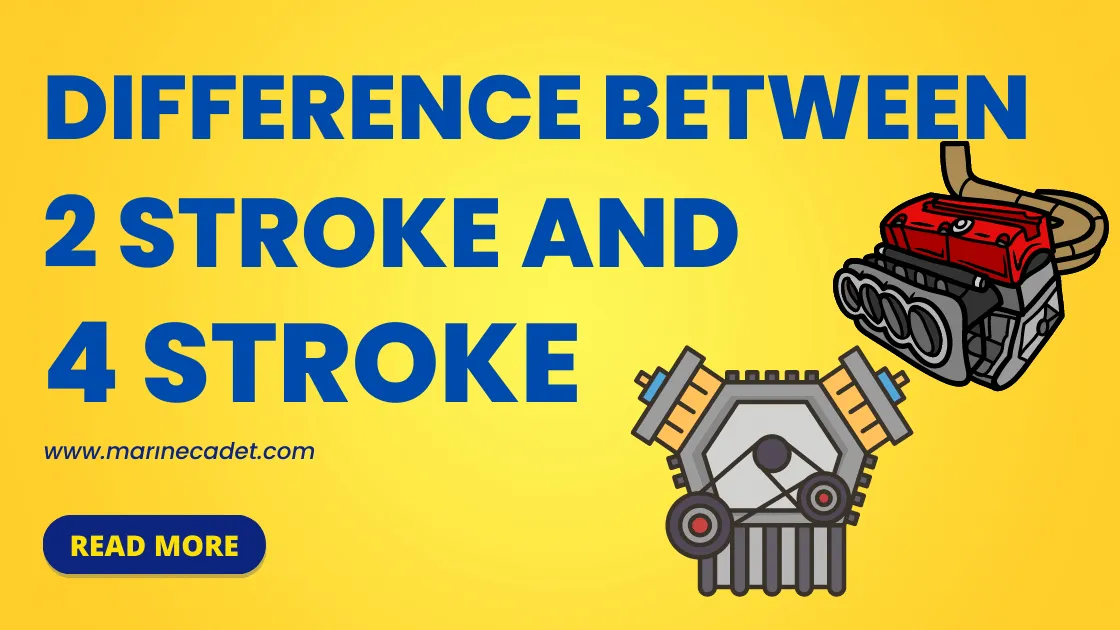
Before explaining the difference between 2 stroke and 4 stroke. Let’s answer the question of what is stroke. In internal combustion engines, the term stroke is used to indicate at what stage the piston movements are. A full revolution of the piston between the bottom dead center and the top dead center is called 1 stroke.
Difference Between 2 Stroke and 4 Stroke with table
To summarize the Difference between 2 stroke and 4 stroke Engine
| 2 Stroke Engines | 4 Stroke Engines |
|---|---|
| It has fewer moving parts. | It has more moving parts. |
| Uses port for inlet and outlet of fuel | Uses valve for inlet and outlet. |
| Maintenance costs are lower due to fewer moving parts. | It is a complex system with many moving parts. Therefore, maintenance costs are higher. |
| Generates more torque at a higher rpm. | Generates higher torque at lower rpm. |
| It requires a lighter flywheel to cause a more balanced force due to one revolution for one power stroke | It requires a heavy flywheel because it gives rise to unbalanced forces due to ‘two revolutions for one power stroke |
| More power generation | Less power generation |
| The charge is partially burnt and it gets mixed with the burnt gases during the inlet. | The charge is fully burnt and doesn’t get mixed with the gases inside the cylinder. |
| Produces more heat so it requires greater cooling and lubrication. | Generates less heat. |
| It can generate one revolution of the crankshaft within one power stroke, one power stroke per 360 degrees rotation of the crankshaft | It can generate two revolutions of the crankshaft between one power stroke i.e., one power stroke in every 720 degrees rotation of the crankshaft. |
| Lower thermal efficiency. | Higher thermal efficiency. |
| Two-stroke engines are used in scooters, motorcycles, military tanks, and also in ship propulsion. | Four-stroke engines are used in cars, motorboats, modem bikes, and aircraft |
| Requires more lubrication while functioning as some oil burns with the fuel as due to poor lubrication more wear and tear occurs. | Comparatively smooth at functioning and requires less lubrication (less ‘wear and tear occurs). |
| Very noisy. | Produces less noise. |
| Lower volumetric efficiency as the time of induction of charge is less. | High volumetric efficiency due to a greater time for induction of charge. |
| Generates a lot of smoke due to poor efficiency. | Generates less smoke due to greater efficiency. |
2 Stroke Engines
A two stroke engine is a type of internal combustion engine that completes a power cycle with two strokes of the piston during only one crankshaft revolution. This is in contrast to a “four-stroke engine”, which requires four strokes of the piston to complete a power cycle during two crankshaft revolutions.
Two-stroke(2 stroke) engines have several benefits over four-stroke engines. They are generally lighter and more compact, which makes them ideal for use in small vehicles such as motorcycles, scooters, and outboard motors.
They also have fewer moving parts, which makes them simpler and cheaper to manufacture and maintain. Additionally, two-stroke engines can have a higher power-to-weight ratio than four-stroke(4 stroke) engines, which means they can produce more power for a given size and weight.
However, two-stroke engines also have several disadvantages. They tend to be less fuel efficient than four-stroke engines, which means they consume more fuel for a given distance traveled. They also tend to emit more pollutants, such as unburned fuel and oil, which can be harmful to the environment.
Additionally, two-stroke engines require special lubrication systems, such as oil injection or premixing, which can add to the complexity and cost of the engine.
4 Stroke Engines
A four stroke engine completes a power cycle with four strokes (intake, compression, power, and exhaust) of the piston during two crankshaft revolutions. This is in contrast to a “two-stroke engine”, which requires two strokes of the piston to complete a power cycle during one crankshaft revolution.
Four-stroke engines have several benefits over two-stroke engines. They tend to be more fuel efficient, which means they consume less fuel for a given distance traveled.
They also tend to emit fewer pollutants, such as unburned fuel and oil, which makes them better for the environment. Additionally, four-stroke engines do not require special lubrication systems, such as oil injection or premixing, which makes them simpler and cheaper to manufacture and maintain.
However, four-stroke engines also have several disadvantages. They tend to be heavier and more bulky than two-stroke engines, which makes them less ideal for use in small vehicles such as motorcycles, scooters, and outboard motors.
They also have more moving parts, which makes them more complex and more expensive to manufacture and maintain. Additionally, four-stroke engines tend to have a lower power-to-weight ratio than two-stroke engines, which means they produce less power for a given size and weight.
Final words
In summary, two-stroke engines are lightweight, compact, and have fewer moving parts and higher power-to-weight ratio, but are less fuel efficient, emit more pollutants and require special lubrication systems. On the other hand, four-stroke engines are more fuel efficient, emit fewer pollutants and don’t require special lubrication systems but are heavier, bulky and have more moving parts and lower power-to-weight ratio.